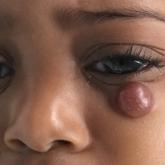Article

Clustered Vesicles on the Neck
- Author:
- Delice Kayishunge, MD, MSc
- Benjamin T. Rollins, MD
- Laura A. Gonzalez-Krellwitz, MD
- Megan S. Evans, MD
A 6-year-old girl presented to the dermatology clinic with a rash on the right side of the neck that was noted at birth as a small raised lesion...
Article

Rubbery Nodule on the Face of an Infant
- Author:
- John R. Chancellor, MD, MS
- Laura A. Gonzalez-Krellwitz, MD
- John D. Pemberton, DO, MBA
A 10-month-old girl presented with a facial nodule of 7 months’ duration that started as a small lesion. On physical examination, a single 10×10-...
